Racing Solo in La Boulangère Mini Transat, an Extraordinary Adventure
You can sail solo across the ocean for 19 days fueled by mostly 12-minute naps and not hallucinate. You might even be able to communicate by telepathy. But things go sideways. What you hope to be an astonishing feat may feel like a failure along the way. These are among the lessons I learned from Peter Gibbons-Neff, the only American sailboat racer to cross the finish line of the 4050-nautical-mile La Boulangère Mini Transat Race on November 15.
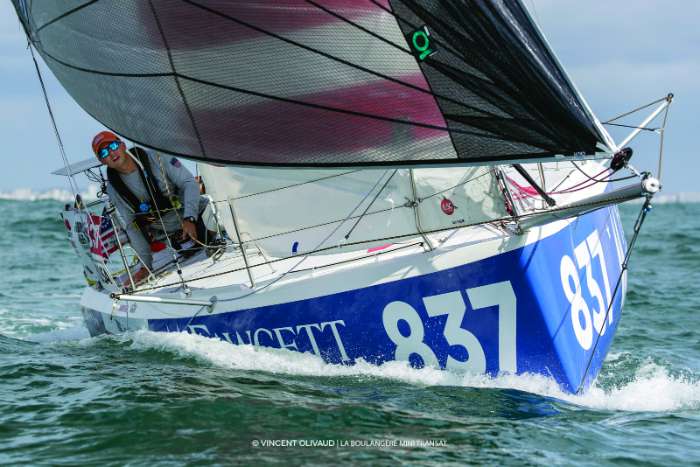
What’s “mini” about a trans-Atlantic race? The boat: a 21-footer built for racing across the ocean. Sailors who find their way to the “pocket rocket” they call the Classe Mini 6.50 tend to be experienced solo ocean sailors and/or French. Gibbons-Neff was neither.
Born into a Philadelphia sailing family, Gibbons-Neff started as a kid racing around the buoys on his parents’ Farr 395, notched his first (rough) Annapolis to Newport Race at the age of 13, and raced 420s out of Severn Sailing Association in high school. He sailed for four years as a Midshipman on the U.S. Naval Academy Varsity Offshore Sailing Team, with a highlight being skippering a TP 52 in the 2010 Newport to Bermuda Race against his family.
Following his graduation from USNA in 2011, Gibbons-Neff served in the Marine Corps for a decade. Once off active duty, “I wanted to get into the offshore world and figure out how to get into professional sailing,” he says. “Covid had shut everything down, so it wasn’t a great time for it.”
Although he had no solo or doublehanded racing experience, he found a Mini for sale in Annapolis by Vernon Hultzer, a seasoned yacht racer who had completed numerous ocean races onboard, including a number of doublehanded Bermuda 1-2 Races with his sailing partner and wife Heather. (He coined the expression “pocket rocket” in a previous SpinSheet interview).
Gibbons-Neff’s own sailing partner and girlfriend, Jane Millman, was game to take the new Mini for a spin.
“Jane and I sailed the boat a few times that fall. Once I bought the boat, I committed to doing a Mini Transat.”
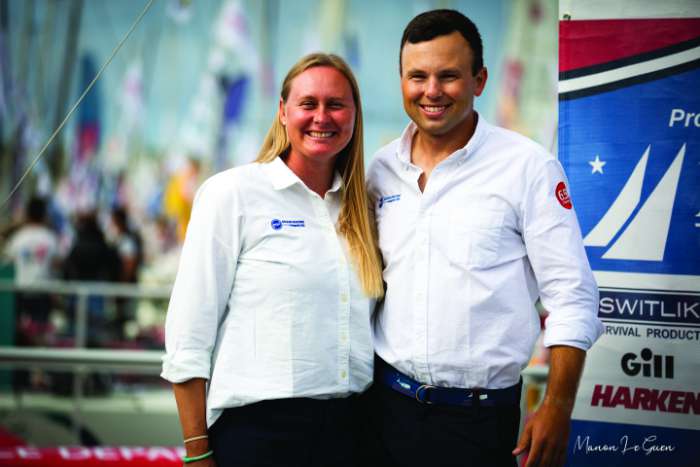
Terminal Leave en France
Extensive boat work plus logging miles onboard proved to be the bulk of the preparation for the race once he had the boat—now named Terminal Leave—shipped to western France, the Mecca for Minis.
“I wish I could have done more training but couldn’t stay in France more than three months at a time since I’m not a resident… The best training was the 2600 nautical-mile SAS: Les Sables-Azores-Les Sables Race.”
A thousand of Gibbons-Neff’s 8000 miles sailed on Terminal Leave before the start of the Mini Transat in September were doublehanded with Millman, who is also a lifelong competitive sailor. A delivery from France to Ireland and back made up some of those miles; a doublehanded race added more. Millman has worked in the marine industry for more than 20 years, 15 of them in program management, which made her ideal shore support for Gibbons-Neff’s Mini Transat. She researched logistics, did social media, blogged, and managed operations.
A dazzling sendoff
On September 26, 90 solo sailors departed Les Sables d’Olonne, France, for the first leg of the 2023 Boulangère Mini Transat. Competitors hailed from 17 countries as far as Argentina and Japan and as close as Switzerland. Gibbons-Neff was the only American. Fifteen percent of the entrants were women.
“The start is so different from any other race,” he says. “You leave from one of the most famous pontoons (floating docks) in sailing. When you head out into the channel, the whole town comes out to cheer you. There’s nothing like it. The Mini Transat signs are on the light posts all over town and the race village. Spectators can walk the docks. It’s a really big event there.”
That first 1300-mile leg from France to La Palma in the Canary Islands was “a wild experience,” says the skipper. “You have 90 boats at the start, and within a couple of hours you’re by yourself out there. There are days when you don’t see anyone.”
Because of some strong weather, organizers added a southern waypoint. “Getting out of the Bay of Biscay is one of the hardest parts because of the weather systems that come in there. High winds (40 knots), big seas (nine-to 13-foot seas). You’re by yourself, so there’s a lot that goes into it. Tacking a boat like that when it’s blowing may take an hour! You must arrange everything below, get the sails ready, and more.”
Gibbons-Neff finished the first leg mid-pack. Although he would have liked to have finished stronger, he was pleased. The three week “break” in the Canaries included “rest and repair” as well as events, such as the awards ceremony, spot safety checks (to ensure that the boats are compliant), and daysails so that spectators could see the boats.
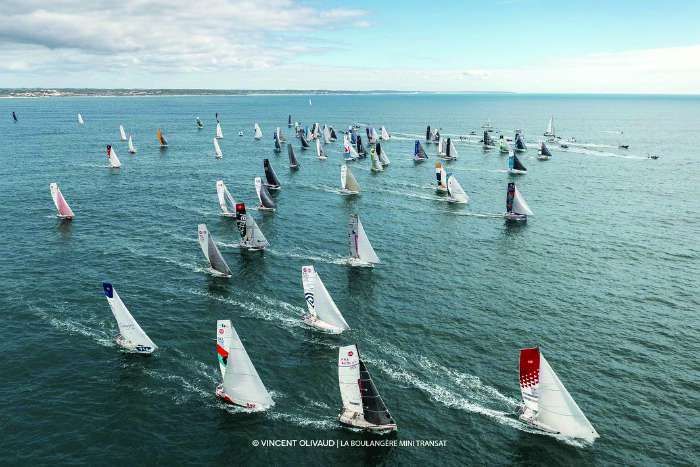
Things go sideways
Once the 2500-mile second leg started, the skipper pondered many tactical decisions. “A lot of the boats headed northwest above the rhumb line initially,” says Gibbons-Neff. “There was an area with no wind as you had to go way south or way north. I ended up going way south, a more conservative and safe option, where I’d have trade winds.”
On the sixth day, “I was headed west and flying with two reefs in the main, a reef in the jib, and one in the spinnaker. I was probably going faster than 10 knots, with big seas and big wind. It was awesome. At that point (at about 1 p.m.), while hand steering, I lost a bit of control and could see one of my two rudders dragging a few feet behind the boat. The only thing holding it was the tiller bar that goes to the top of the rudder. I went into crisis management mode. I had to: 1) save the rudder, 2) stop the boat, and 3) make sure I didn’t sink, all at same time.”
Luckily, there was “no damage to the hull itself. I was able to save the rudder and drop the sails, but the repair went beyond what I could do at sea with three-meter seas and the boat getting thrown around a lot. Because I only had one of the rudders, I put up a sail and headed south. I still had 2000 miles to the finish line, so I didn’t think about it for too long. The good news was that Cape Verde was about 270 miles to the south. It was downwind with the good rudder. With only one rudder, if the boat hadn’t been flat, the boat would have wiped out.”
Read my mind, Peter
Gibbons-Neff had a GPS tracker onboard with a minimal texting function. He says, “I notified the race committee (RC) via preset text message: ‘presence onboard.’ They could tell there was a problem because I was diverting course and going slowly. Two hours later, once I got all sorted onboard, RC asked me what the problem was. I couldn’t text too much due to the rules, so I wrote: “rudder broke off/ Cape Verde repair.” Satellite phones are prohibited onboard as well as any outside coordination.
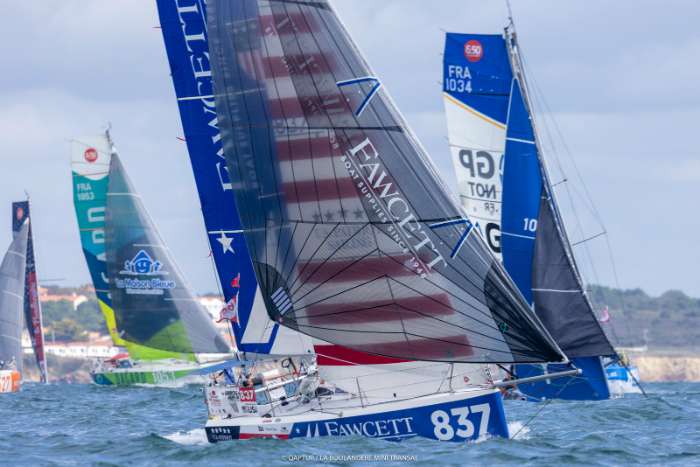
Millman had been tracking Terminal Leave closely throughout the race and noted that the boat had gone from sailing at 13 knots to 1.9.
She says, “At this point he was close enough to the coast of Africa that I was able to track him in real time by AIS. I went into action to see how we could get this fixed without knowing exactly what it was. I reached out to sailing networks (The Magenta Project and the Women Who Sail Facebook page). Offers of help started pouring in.”
“I looked to the notice of race to see what charts he kept onboard and the two marinas listed. One was in Priai, the southernmost island. I was praying and trying to communicate telepathically to Peter to have everything into place before he showed up. I had almost every contingency in terms of rudder repair ready for him. A woman in France was ready to fly to Cape Verde with Peter’s spare. I had designs from the boat designer and builder to send to Mindelo (farther north) and had someone ready on the dock with phone ready for Peter to call me.”
Gibbons-Neff says, “I picked the right place! Porto Grande: I thought it sounded big and like a good option. I had an island book of West Africa so knew just enough to be in the right place.” (This port is in Mindelo on the island of São Vicente, the most northwesterly option for repairs and closest on the racecourse).
The first sailor he came upon was a cruiser from North Carolina who offered him a dinghy ride to shore. After some moments feeling “like a rock star” among the French cruisers, who knew the Mini Transat, and a rapid fix—the rules required a minimum of 12 hours onshore—he departed to recommence his route to the finish line in Guadeloupe.
The art of the 12-minute nap
Rule number one of onboard sleep is risk management: “You don’t want to get run over by a ship,” says Gibbons-Neff. “It all comes down to risk management. It’s amazing how many times I set my alarm for 12 minutes and woke up first. When I’m closer to shore, I take shorter naps. Offshore I take longer ones, the longest one being 40 minutes.”
He did not hallucinate but had done so in the past. “I know my body now; I know where that point is.”
In addition to ship worries, there are no bunks in a Mini packed to the gills with sails and supplies for three weeks offshore. “You end up on top of bags and stuff and holding on at the same time. It’s easy to broach on these boats since they’re so overpowered. Even when you’re napping, your muscles are clenched so that you don’t go flying.”
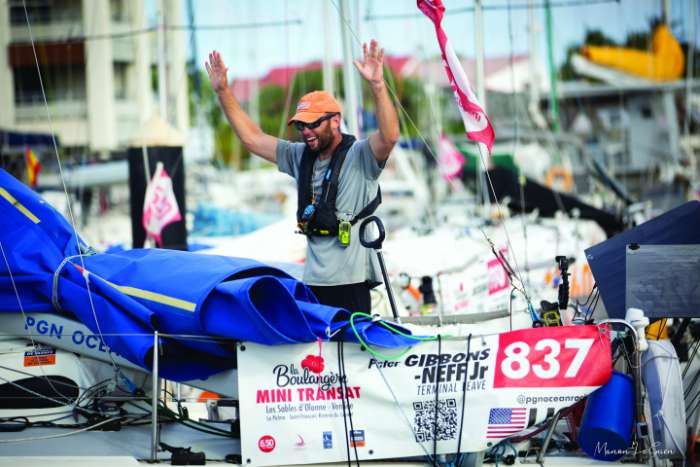
How close is failure to success?
Sleeping in fetal position, eating freeze-dried food supplemented with snacks, and using a bucket as the head felt easy compared to the mental challenges of the race. Experiencing the rudder failure and time setback that placed him 300 miles behind the next boat derailed the master plan.
“I spent the next two weeks sailing across the Atlantic thinking about what a failure I was,” says Gibbons-Neff. “I didn’t’ think many people would be following me. That was one of the most surprising things. Just finishing the race was such an achievement. It was hard for me to process it by myself in the ocean. Mentally, it’s very hard on you.”
What will he remember? “There were probably some days I’ll never remember! I’d be on starboard tack for 24 hours—beautiful sailing in 20 to 25 knots downwind. We received a ranking update daily, so I could see how many miles were left. I sailed 220 miles in a 24-hour period.”
In the last 24 hours of the race, Gibbons-Neff came across another Mini (skippered by Olivier Le Goff). “That was incredible, coming back with another boat. Even when you’re not speaking the same language on the radio, you can still convey the excitement. You’re all going through it together,” he says.
“Oh my gosh, the finish!” The skipper says, “I finished during the day. I had my big spinnaker up and was going 10-12 knots. Three miles from the finish line I got to see Jane out on a media boat. It was a very special experience. That finish line was for the race, but it was also a three-year-long process before that moment.”
Gibbons-Neff finished second to last. He says, “Obviously, I wasn’t happy with how I finished, but overcoming the challenges to get to the start line and do the race itself outweighed anything else.”
Millman adds, “It was our life’s work for three years, and now we don’t know what’s next. Every once in a while I say, ‘You just sailed across the Atlantic in a Mini!’ Competitors are so amazed at how hard he pushed. They were so encouraging. The camaraderie and friendships in this group are incredible.”
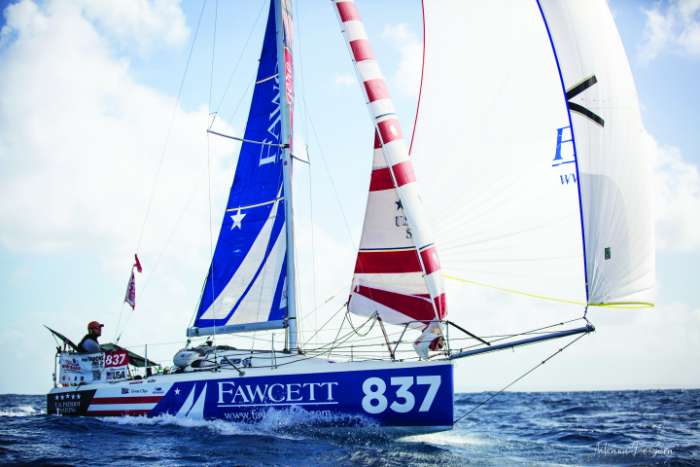
Gibbons-Neff extends thanks to US Patriot Sailing sailors “who were a big part of getting me back into sailing and racing in Annapolis;” Fawcett Boat Supplies who “opened their doors to me and loaded the boat with equipment;” and Switlik Survival. He adds, “A lot of individuals gave financial contributions, which helped so much.”
At print time, Gibbons-Neff and Millman were uncomfortably, yet happily cruising Terminal Leave back to Florida and eventually home to Annapolis.
He says, “I want to share this experience with folks in Annapolis. I’m going to do the Sailboat Show in the fall and some races on the boat. I’m looking forward to spending time with US Patriot Sailing and the veterans in the program. I’ve missed my support network the past few years… and I’d like to support veterans in the long run.”
Find more about PGN Ocean Racing and Gibbons-Neff’s podcast at pgnoceanracing.com.
~by Molly Winans
Find more great sailboat racing stories here.




